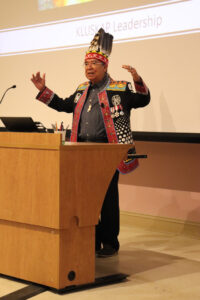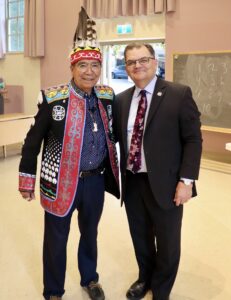In the first week of the program, FYP students learned an origin story that teaches interdependence, gratitude and the importance of our relationships with one another.
“Where do I begin?” Chief Stephen J. Augustine asked an auditorium full of Foundation Year Program students as he opened his lecture on the Mi’kmaw Creation Story.
 “At the very outset,” Chief Augustine continued, “This is not a religion. We don’t have a book that we follow… Whatever it is we do today, whatever I do today, it’s backed up by my grandparents, my parents, my father, my uncles, my great-grandfather, my great-grandmother… They brought down the stories.”
“At the very outset,” Chief Augustine continued, “This is not a religion. We don’t have a book that we follow… Whatever it is we do today, whatever I do today, it’s backed up by my grandparents, my parents, my father, my uncles, my great-grandfather, my great-grandmother… They brought down the stories.”
As President William Lahey pointed out while introducing Chief Augustine—who is a Hereditary Chief on the Mi’kmaq Grand Council and Executive Director of Cape Breton University’s Marshall Institute—the Mi’kmaw Creation Story is the third origin story the students learned about in their first week of the program—the first two being the Epic of Gilgamesh and the Book of Genesis.
“The Creation Story has more depth than a simple tale about our origins,” Chief Augustine says in “Negotiating for Life and Survival,” one of the required readings for the lecture. “Since time immemorial it has been the vessel of our clan’s history, our system of values, our modes of governance and our relationships with each other,” (17).

Chief Augustine explained that it was his grandmother, Agnes (Thomas) Augustine, who passed the Mi’kmaw Creation Story down to him, along with the oral history and traditions she collected over her 100-year life. Now, Chief Augustine carries these stories and traditions on.
The Mi’kmaw Creation Story depicts seven levels of Creation, which continue to guide Mi’kmaw ceremonies and practices today. Kluskap, Chief Augustine explains, was the first person to come into existence. Created from three bolts of lightning striking Mother Earth, Chief Augustine described Kluskap as “the figure that gives us a way of life that we need to follow.”
Through Kluskap’s journey, the seven levels of Creation and their teachings are unveiled. First, there is Kisu’lkw, “the Great Spirit or Giver of Life,” then Grandfather Sun, who, by shining down on Kluskap and giving him his shadow, teaches us we are never alone. Third is Mother Earth, who gives up parts of herself for Kluskap’s Creation, and who, through her nourishment, teaches gratitude.
“The Earth, like our mother, provides us with all the necessities of life,” said Augustine. “The birds, the plants, the animals, the fish, the water, the air and the fire…. So we are grateful to our mother, the Earth.”
The fourth level of Creation is Kluskap himself, who, in learning to survive, learns to negotiate and form relationships through ceremony and gratitude. It is these ceremonies and negotiations that Chief Augustine emphasized in his telling of the Creation Story in Alumni Hall.
Kluskap encountered a small animal, apistane’wj (marten), and asks for his life so that Kluskap may feed himself and his family. In this negotiation, Kluskap offered a gift of tobacco, and apistane’wj agreed. Kluskap apologized to Mother Earth for taking part of Her Creation and requested that she give apistane’wj back his life, so that Kluskap may enter into an ongoing relationship with him, and other animals, forever.
“It’s a negotiation for our survival,” said Chief Augustine. “We form these relationships. Yes, we take the life, but we know that the Giver of Life, Grandfather Sun and Mother Earth will regenerate that life and will continue the same with us. We rely on a world that is interdependent.”
The final levels of Creation were Kluskap’s family members—his grandmother, who guides and teaches him, his nephew, whose youth and strength creates a legacy of survival, and his mother, who brings love and understanding.
At its core, Chief Augustine explained, the Creation Story is about family. “Our elders are always teaching us. You have to be kind to all animals because they are our relatives. Everything that’s on Mother Earth. Even this branch,” he said, holding up a small branch he had cut from outside the New Academic Building, “Even this branch is still my relative. It’s still here. It’s still alive.”
In his chapter, “Mi’kmaw Creation Story,” within the book Visioning a Mi’kmaw Humanities: Indigenizing the Academy, the second required reading for the lecture, Chief Augustine explains that “there are many principles, morals, ethics and values of how to live as a Mi’kmaw Ilnu that are hidden in the Creation Story, and when our Elders tell the story to our people, they emphasize the parts they want to use as their teachings,” (28).
This was the third year Chief Augustine has shared the Creation Story with Foundation Year Program students. The kindness for everything on Mother Earth, and the relationships, ceremonies and negotiations that create interdependence, were emphasized by Chief Augustine in his most recent retelling of the story for Foundation Year students—imparting that survival depends on reliance on one another.

